
Search rankings are an important part of any digital marketing strategy, but did you know that Google site links (Google sitelinks) are a good way to generate extra traffic?
Let’s go back and have a look. The top ranking of key keywords can bring you continuous related traffic and help your website succeed (and develop). However, while it’s good to be at the top of the rankings, rankings are meaningless if people can’t really click into your site from SERP.
This is what links to Google search sites are for. They take up more “space” on Google, allowing more people to click on your site in search results.
Google site links are a good way to increase click-through rate (CTR). It will help you generate more traffic and enhance your search engine optimization.
So, what exactly is sitelinks and how to get it?
What is Google Sitelinks?
Google sitelinks appears below the first search result on the search engine results page (SERP). They are internal links to the site with a short description. Sitelinks is often found when doing brand searches, which help users navigate your site.
You may have seen two, four, or six internal links below the top results of the Google search. These are Google Google sitelinks, and they look like this:

Google sitelinks in SERP
When searching for a brand, the home page may not be the page most relevant to the user’s needs. Users who search for “Barneys” may click on the site link to “Designer Women’s Clothing” to go directly to the page instead of the home page.
This provides a better user experience and allows users to go directly to the page of their choice without extra clicks.
Four reasons why Google Sitelinks is very important
There are many reasons why sitelinks can benefit websites and visitors.
Here are four reasons why Google sitelinks is important to a website:
1. Google Sitelinks can increase click-through rate (CTR)
A good click rate depends on the popularity of the link, which is directly related to the relevance of the link to a particular search query. A person may conduct a simple brand search, while site links provide more relevant pages, which may lead them directly to the product or service they want.
But why care about the click-through rate? According to AWR, Google’s first three search results get, on average, most clicks. Then the click-through rate will drop rapidly:
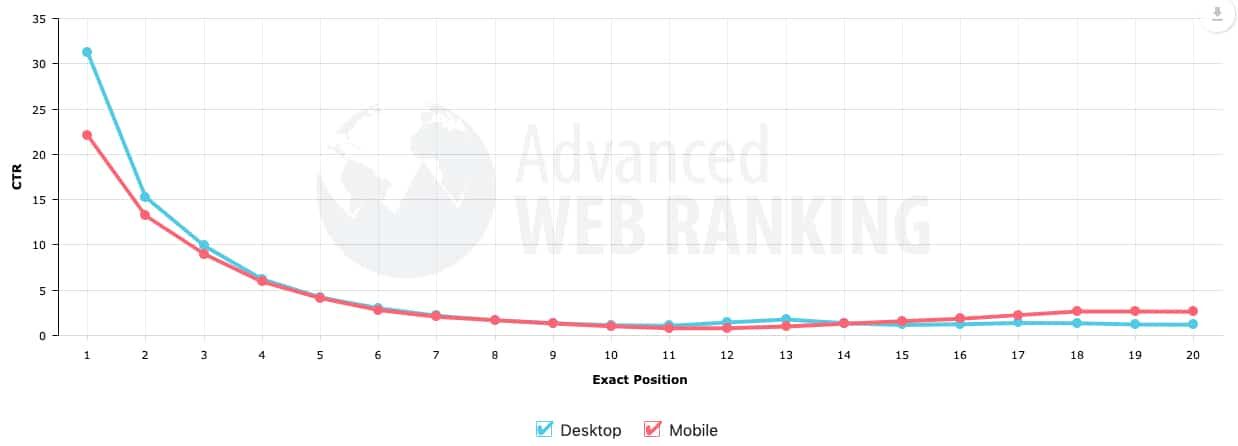
Click research
Giving searchers instant access to your most popular web pages will help attract them to click from the search engine. The more people click on your site in SERP, the higher your ranking in the search term, thus increasing your natural traffic.
In fact, Google search’s sitelinks has been shown to increase click-through rates by 64%, so trying to optimize the site’s sitelinks is a worthwhile investment.
2. Google Sitelinks builds trust and credibility
Not all websites display Sitelinks. Sites that are less well-known or poorly optimized are less likely to display Sitelinks in SERP.
Google said:
We show Sitelinks in search results only if we think Sitelinks is useful to the user. If the structure of your site does not allow our algorithm to find a good Sitelinks, or if we think that the Sitelinks of your site is not related to the user’s query, we will not display them.
If a website shows sitelinks, it means that the website is well structured and sitelinks is related to the user’s query.
After all, Google wants to provide the best answers to searchers’ queries. Because sitelinks takes up a lot of space in Google search results, they don’t set aside so much space for poorly optimized or untrusted sites.
Sitelinks takes up a lot of “space” on Google, just look at how much space sitelinks takes up on the desktop:

Google sitelinks on desktop browsers
The same sitelinks on the mobile device (which occupies most of the screen):

Google sitelinks on mobile browsers
Both of these factors help to improve the credibility of the site, and not all results have these factors, which gives a unique feeling.
Some sites even add search boxes to sitelinks:

Google sitelinks search box
This allows users to search for external sites directly from search results. The addition of the search box will once again improve the click-through rate and user experience, so that they have a better overall evaluation of your site.
3. Google Sitelinks can improve brand and product awareness.
Google sitelinks aims to show searchers the most important pages of the site to improve their search experience. Google considers these pages to be the most relevant based on the structure, content and related search terms of the site.
The pages Google chooses as sitelinks are usually product pages, price pages, about pages, or blogs that help users learn more about the site or company.
Fomo’s sitelinks does a good job of highlighting the company’s key pages (about us), useful product pages (integration, product guides, etc.), as well as pricing pages and blogs.
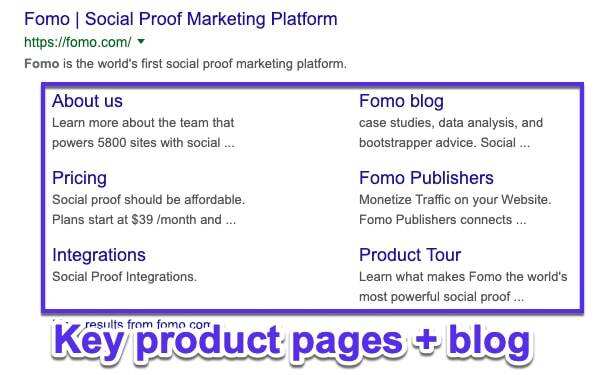
Brand awareness sitelinks
When conducting a brand search, the sitelinks for a specific product or series may be displayed, such as GoPro in this example:

Product series sitelinks
This helps let users know about the products you offer without having to visit your website. It also accelerates the speed at which prospects are directed to your best / most popular product pages.
4. Google Sitelinks allows users to browse deeper pages
Most visitors will not delve deep into your website. In most cases, users only browse the home page, product page, and service page of the site, but do not have an in-depth understanding of the content of the site.
Google search sitelinks will display the site’s most popular pages, which means that your most popular blog posts, best-selling products, or frequently downloaded instructions will appear in the form of site links.
The website of Paul Jarvis, a web designer turned entrepreneur and writer, is a good example, where popular articles and product pages have been added to sitelinks:
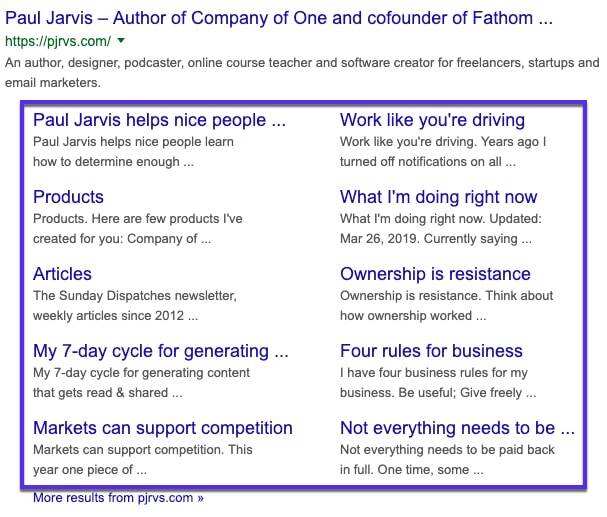
Deeply linked sitelinks
This is also very effective for software tools. For example, Ahrefs’s sitelinks can pull in a specific tool page:

Tool page sitelinks for Ahrefs
This directs traffic to the most important pages and helps provide clues such as advice and subscriptions, rather than directing everyone to the home page. Therefore, while improving search engine optimization and click-through rates, sitelinks can also help you improve conversion rates.
Tip: Google sitelinks is not something you can enable, activate or choose to join. Google believes that the site is authoritative in certain queries, so it will enable sitelinks for the site.
Even if sitelinks is not something you can set up, following search engine optimization best practices can greatly increase your chances of getting sitelinks.
How to get Google Sitelinks for your website
Let’s start with the bad news:
Unfortunately, you cannot set up your own sitelinks. Whether they appear or not and which links to choose depend entirely on Google’s algorithm. However, as with other aspects of search engine optimization, you can follow some best practices to improve your chances of getting links to your site.
Let’s discuss it in detail.
1. Have a unique website name
Sitelinks in Google search is mainly for brand search, so having a unique brand name will help your site rank high.
Generic names like “The Digital Agency” will be hard to rank because it’s hard for Google to know whether users are searching for a general digital organization or a particular company.

Universal brand name is not conducive to obtaining Google sitelinks
Under the right conditions, vague company names can sometimes get a good ranking. For example, a search for “apple” will yield the results of a tech giant rather than a fruit, because Google knows the user’s intentions.
However, without strong brand influence, it is difficult for a fairly common name to get a ranking.
If your company has been set up, don’t change its name in order to do better SEO, because it is a very complex task and there are many risks and difficulties.
If you are in the early stages of starting a business, choose a unique company name, which will help you achieve good results in brand search. This is your guide to successfully starting and running a company.
two。 Put your brand name first
Google sitelinks is only assigned to the first search result, so if you want to have access to these sitelinks, you must put your brand name first.

Put your brand name first to get sitelinks
While ensuring that your website or company name is unique, you should also enhance the online influence of the brand as much as possible.
Review your backlinks to check that all online references use the correct name, address, phone number, and URL. Keep social media materials active and use content marketing methods such as blogs to further spread your brand online.
3. Using structured data
Structured data, also known as rich snippets or schema, can help Google and other search engines better understand your site.
Structured data can help improve the display of your site in SERP in a number of ways, such as displaying comments or event fragments, but it can also help you with site links.
You can tell Google which menus should be considered for site links, specify about or contact pages, and enable breadcrumbs or site link search boxes.
Although the usage mode does not guarantee that Google will display site links, nor does it guarantee that site links will always be the links you specify, it is a good way to push the site in the right direction.
4. Use clear website structure and navigation
Sites with complex or unclear structures are difficult to crawl by search engines such as Google, and it is also difficult for users to browse.
If Google can’t find all your pages and doesn’t know the relationship between them, it can’t assign site links. Take a look at this example of website architecture:
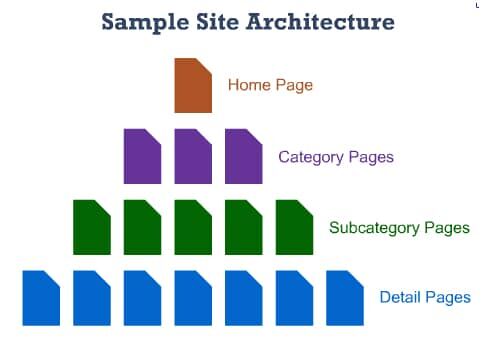
A clear example of a website architecture
Make sure that the home page is the main page of the site and that all other pages can easily branch out from it. Organize the page with a clear title and intuitive structure, and divide all the content into relevant subcategories as much as possible.
It is also preferable to cover “standard” pages, such as about, contacts, and products / Services. These pages are easy to understand by Google and users, and are good landing pages on SERP.
5. Add a XML sitemap to Google Search Console
Sitemaps help search engines understand and crawl your site and determine which pages are the most important.
If you have a clear site structure and link the site map to your Google Search Console account, Google will have an advantage in crawling and analyzing your site.
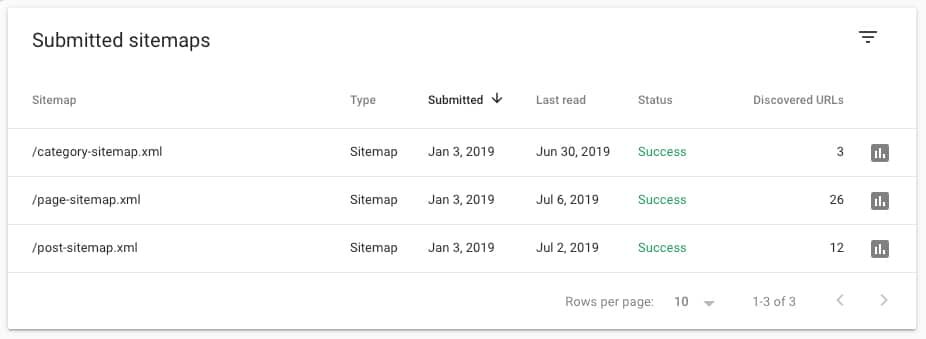
Example of a successful site map
When selecting which pages to use as site links in SERP, Google looks at the priority and traffic of each page to evaluate its usefulness to searchers. By adding a site map to Google Search Console, you can help Google select the most relevant site links.
You can also monitor which posts meet the criteria of the sitelinks search box.
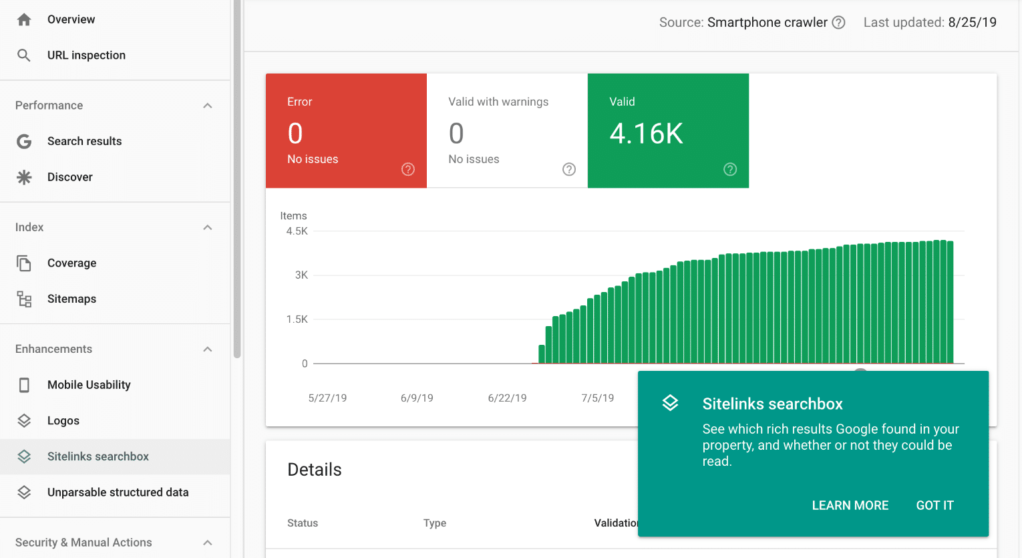
Google sitelinks searchbox
6. Establish internal links
Internal links are an important part of search engine optimization (sometimes ignored). The more times you link to a page within the site, the more important that page will be in Google’s view.
If your page is often linked to a product, contact page, or page about you, then these pages are the best choice for links to Google sites.
Use internal links to guide users (and Google) to the site. Nat Ellison (Nat Elison) does this very well in his article on marketing books:
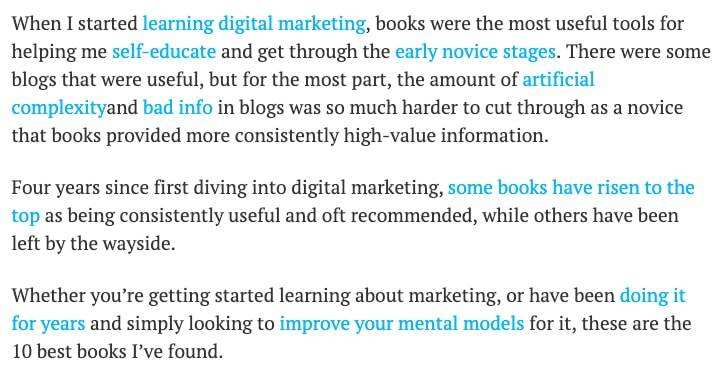
Internal links: the example of Nat Ellison
All of these internal links guide users to his site and take them to relevant content they may find useful.
Actually, that’s what we do here. Please read this article on outbound marketing:
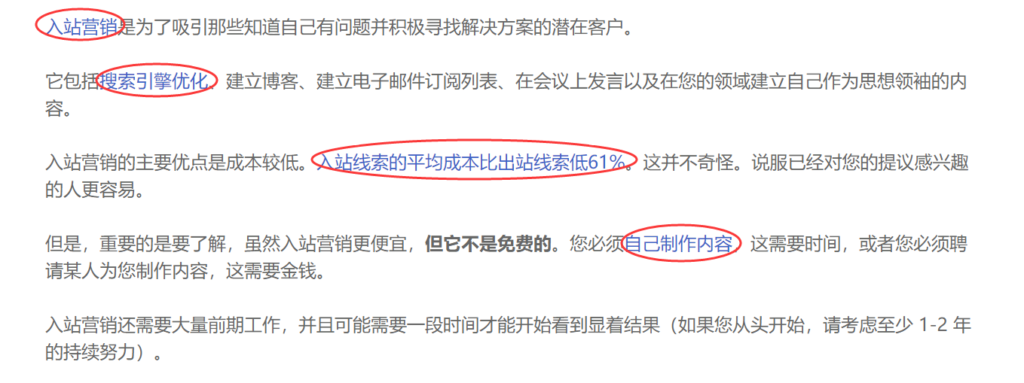
Intra-site link
In the content, we added internal links to other articles related to the topic. This will not only help Google Crawler browse our site better, but also help users browse our site while browsing our content.
If you want to know the overall situation of links within the site, you can track it in the Google search console (Google Search Console) to see how many times the site is linked to a specific page. If you particularly want to add a page to your site link, make sure you link to that page in the rest of the site.
7. Use related page titles
This is SEO 101. The page title is one of the most important SEO elements on the site.
Ensuring that each page has the most effective title helps improve overall search engine optimization and helps Google pick the relevant sitelinks.
The Google sitelinks is generated based on the page title, so make sure that the title is consistent with the page content. Trello has done a good job in this respect:
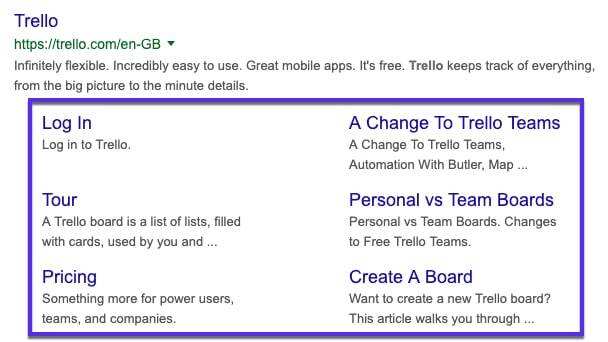
Sitelinks of Trello
The title of each page should briefly and reasonably describe the content of the page. Headlines that have nothing to do with the content of the page can confuse Google, which means they will be hard to rank-and you can say goodbye to sitelinks.
It’s tempting to use interesting or unusual titles for pages, but be aware that this may affect search engine optimization and sitelinks allocation. For example, the about page titled “knowing what makes us work so hard” is not particularly clear for Google’s search algorithm.
8. Improve brand awareness
It does not happen overnight to improve brand awareness. This is an ongoing process.
Further dissemination of your brand name online will help improve the authority and awareness of your site, both of which Google uses to determine rankings.
Build a good reputation for your company and make sure people have heard of you. Here are some ways to get your brand out:
- Write guest blogs on popular industry websites.
- Give an interview.
- Contact an online news organization.
- Get positive comments and recommendations.
- Participate in online community discussions.
The more people know your company’s name, the more brand searches you will receive and the greater your chances of getting links to the site.
Note: Google AdWords Sitelinks
It is worth noting that Google AdWords sitelinks is different from Google search sitelinks.

Google AdWords sitelinks
When you set up an AdWords ad campaign, you can choose to add site links to the ads to help guide users to specific pages. You can also add a short description of the site link to make your ad more relevant and useful to the viewer.
Although they look very similar and function the same, AdWords site links are added by advertising campaign managers, while organic site links are generated by Google and cannot be specified by site owners.
Summary
Now you know how to get a link to the site. Go out and get them!
I can’t guarantee that you will get links to the site, and I can’t guarantee that they will appear every time. But if you can give the time, the benefits are worth it.
By following these steps, you can increase your chances of getting links to your site, thereby increasing organic traffic, potential customers, and brand awareness.
Like any element of SEO, getting links to a site doesn’t happen overnight. All you can do is follow the best practice guidelines and persevere in search engine optimization to provide yourself with the best opportunity to win links to these sites. And be patient.

